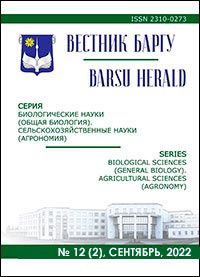ВЛИЯНИЕ ПЕСТИЦИДОВ НА ТАКСОНОМИЧЕСКУЮ И ТРОФИЧЕСКУЮСТРУКТУРЫ СООБЩЕСТВ ЖЕСТКОКРЫЛЫХ (COLEOPTERA)НА ПОЛЯХ РАПСА
Ключевые слова:
озимый рапс; яровой рапс; жесткокрылые; трофические группы; пестицидыАннотация
В статье приведены данные по видовому составу жесткокрылых на посевах озимого и ярового рапса в вегетационные периоды с 2016 по 2018 год и влиянию пестицидов на структуру сообщества жесткокрылых.
На полях озимого рапса отмечено 103 вида фитофагов из 8 семейств, 79 видов зоофагов из 6 семейств и 47 видов сапрофагов и мицетофагов из 13 семейств. На полях озимого рапса количество видов и численность фитофагов всегда была выше, чем зоофагов.
На полях ярового рапса отмечено 50 видов фитофагов из 5 семейств, 48 видов зоофагов из 4 семейств, 20 видов сапрофагов и мицетофагов из 7 семейств. Общая численность собранных экземпляров зоофагов была на 10 % выше, чем фитофагов.
Среди них основными зоофагами являются Carabidae, а основными фитофагами — Chrysomelidae. Полифаги представлены только Anthicidae: на полях озимого рапса — 3 вида, на полях ярового рапса — 2 вида.
Применение пестицида Пилараунд экстра привело к снижению численности жуков на 22—45 %. Использование инсектицида и акарицида Маврик привело к сокращению численности жуков на 27 %. Кроме того, применение пестицидов на полях рапса привело к сокращению количества видов жуков, особенно из числа зоофагов, сапрофагов и мицетофагов.
Рис. 3. Табл. 1. Библиогр.: 4 назв.
Загрузки
Опубликован
Выпуск
Раздел
Лицензия
Copyright (c) 2023 Вестник БарГУ Серия "Биологические науки. Сельскохозяйственные науки"
Это произведение доступно по лицензии Creative Commons «Attribution-NonCommercial» («Атрибуция — Некоммерческое использование») 4.0 Всемирная.
Авторы сохраняют за собой право заключать определенные договорные соглашения, касающиеся неисключительного распространения опубликованной версии работы (например, размещать ее в институциональном репозитории, публикация в книге) со ссылкой на ее первоначальную публикацию в этом журнале.





